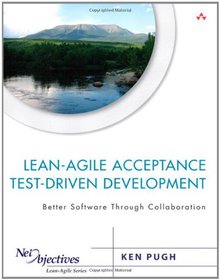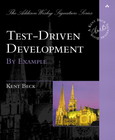Lean-Agile Acceptance Test-Driven Development
Better Software Through Collaboration

Book Details:
| Publisher: | Addison-Wesley Professional |
| Series: | Addison Wesley |
| Author: | Ken Pugh |
| Edition: | 1 |
| ISBN-10: | 0321714083 |
| ISBN-13: | 9780321714084 |
| Pages: | 368 |
| Published: | Jan 01 2011 |
| Posted: | Nov 19 2014 |
| Language: | English |
| Book format: | |
| Book size: | 2.5 MB |
Book Description:
Praise for Lean-Agile Acceptance Test-Driven Development 'Lean-Agile Acceptance Test-Driven Development tells a tale about three fictive project stakeholders as they use agile techniques to plan and execute their project. The format works well for the book; this book is easy to read, easy to understand, and easy to apply.' -Johannes Brodwall, Chief Scientist, Steria Norway 'Agile development, some say, is all about pairing, and, yes, I'm a believer in the power of pairing. After reading this book, however, I became a fan of the 'triad'-the customer or business analyst + the developer + the tester, who work collaboratively on acceptance tests to drive software development. I've written some patterns for customer interaction and some patterns for testing and I like what Ken Pugh has chosen to share with his readers in this down-to-earth, easy-to-read book. It's a book full of stories, real case studies, and his own good experience. Wisdom worth reading!' -Linda Rising, Coauthor of Fearless Change: Patterns for Introducing New Ideas 'The Agile Manifesto, Extreme Programming, User Stories, and Test-Driven Development have enabled tremendous gains in software development; however, they're not enough. The question now becomes 'How can I ensure clear requirements, correct implementation, complete test coverage, and more importantly, customer satisfaction and acceptance?' The missing link is acceptance as defined by the customer in their own domain language. Lean-Agile Acceptance Test-Driven Development is the answer.' -Bob Bogetti, Lead Systems Designer, Baxter Healthcare 'Ken Pugh's Lean-Agile Acceptance Test-Driven Development shows you how to integrate essential requirements thinking, user acceptance tests and sounds, and lean-agile practices, so you can deliver product requirements correctly and efficiently. Ken's book shows you how table-driven specification, intertwined with requirements modeling, drives out acceptance criteria. Lean-Agile Acceptance Test-Driven Development is an essential guide for lean-agile team members to define clear, unambiguous requirements while also validating needs with acceptance tests.' -Ellen Gottesdiener, EBG Consulting, www.ebgconsulting.com, Author of Requirements by Collaboration and The Software Requirements Memory Jogger 'If you are serious about giving Agile Testing a chance and only have time to read one book, read this one.' -David Vydra, http://testdriven.com 'This book provides clear, straightforward guidance on how to use business-facing tests to drive software development. I'm excited about the excellent information in this book. It's a great combination of the author's experiences, references to other experts and research, and an example project that covers many angles of ATDD. A wide range of readers will learn a lot that they can put to use, whether they work on projects that call themselves lean or agile or simply want to deliver the best possible software product.' -Lisa Crispin, Agile Tester, ePlan Services, Inc., Author of Agile Testing Within the framework of Acceptance Test-Driven-Development (ATDD), customers, developers, and testers collaborate to create acceptance tests that thoroughly describe how software should work from the customer's viewpoint. By tightening the links between customers and agile teams, ATDD can significantly improve both software quality and developer productivity. This is the first start-to-finish, real-world guide to ATDD for every agile project participant. Leading agile consultant Ken Pugh begins with a dialogue among a customer, developer, and tester, explaining the 'what, why, where, when, and how' of ATDD and illuminating the experience of participating in it. Next, Pugh presents a practical, complete reference to each facet of ATDD, from creating simple tests to evaluating their results. He concludes with five diverse case studies, each identifying a realistic set of problems and challenges with proven solutions. Coverage includes How to develop software with fully testable requirements How to simplify and componentize tests and use them to identify missing logic How to test user interfaces, service implementations, and other tricky elements of a software system How to identify requirements that are best handled outside software How to present test results, evaluate them, and use them to assess a project's overall progress How to build acceptance tests that are mutually beneficial for development organizations and customers How to scale ATDD to large projects
Download Link:
Related Books:
Agile Java
Crafting Code with Test-Driven Development
Agile Java is a valuable tutorial and reference. It introduces the Java languagewith no assumptions about a developer's background in Java, object-orienteddevelopment, or TDD. The book will also retain significant value as acookbook that readers will turn to time and again to learn how to approachTDD with respect to various language features.Teh author stresses the importance of TDD by showing coded tests for everyJava feature taught. A programmer learning with this book will understand howto translate oral requirements into tests, and tests into working code. Readersalso learn how TDD impacts the design of the system, and vice versa. In short,anyone who wants to understand what it takes to build a professional, robustsoftware system using Java will ...
Test-Driven Development
An Empirical Evaluation of Agile Practice
Agile methods are gaining more and more interest both in industry and in research. Many industries are transforming their way of working from traditional waterfall projects with long duration to more incremental, iterative and agile practices. At the same time, the need to evaluate and to obtain evidence for different processes, methods and tools has been emphasized. Lech Madeyski offers the first in-depth evaluation of agile methods. He presents in detail the results of three different experiments, including concrete examples of how to conduct statistical analysis with meta analysis or the SPSS package, using as evaluation indicators the number of acceptance tests passed (overall and per hour) and design complexity metrics. The book is appropriate f...
Test Driven Development
By Example
Quite simply, test-driven development is meant to eliminate fear in application development. While some fear is healthy (often viewed as a conscience that tells programmers to "be careful!"), the author believes that byproducts of fear include tentative, grumpy, and uncommunicative programmers who are unable to absorb constructive criticism. When programming teams buy into TDD, they immediately see positive results. They eliminate the fear involved in their jobs, and are better equipped to tackle the difficult challenges that face them. TDD eliminates tentative traits, it teaches programmers to communicate, and it encourages team members to seek out criticism However, even the author admits that grumpiness must be worked out individually! I...
2007 - 2021 © eBooks-IT.org



